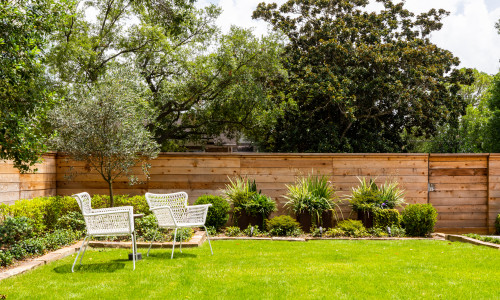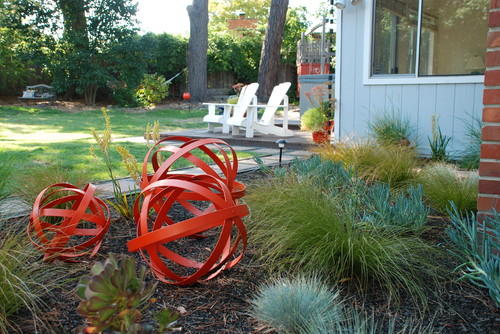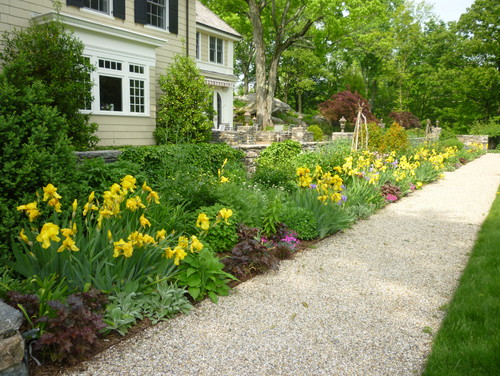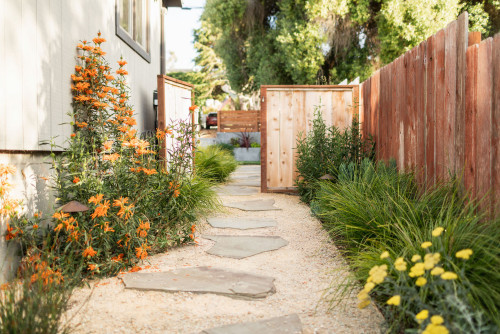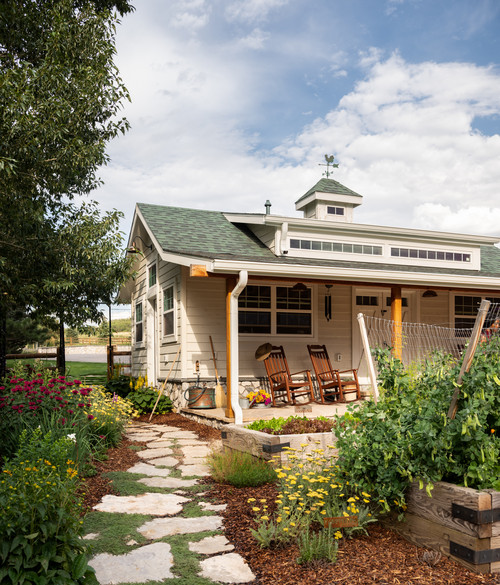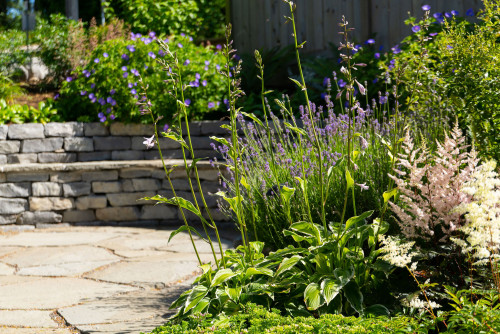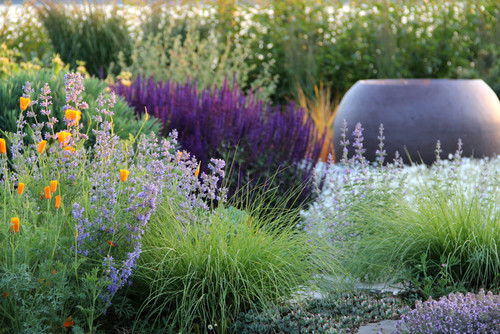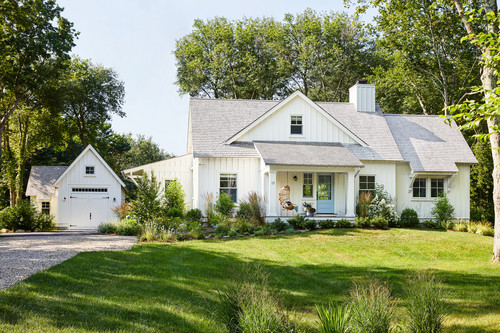How to Transition Your Spring Garden Borders Into Summer
June 2021
Check out these 8 easy tricks for refreshing your garden for the season without entirely replanting.
Thanks to Lauren Dunec Hoang, Houzz Contributor. Landscape designer, a former garden editor for Sunset Magazine and in-house designer for Sunset's Editorial Test Garden. Her garden designs have been featured in the Sunset Western Garden Book of Landscaping, Sunset Western Garden Book of Easy-Care Plantings (cover), Inhabitat, and POPSUGAR.
After the flush of spring blooms has passed and temperatures begin to creep upward, gardens can start to look a little tired, like bouquets past their prime. Don’t fear — you don’t have to start over and replant a fresh garden border for the summer season. Evergreens, colorful foliage plants and long-blooming perennials can help carry a garden from season to season.
Here are eight planting and design tips that can help cut down on seasonal work and set your garden borders up for a smooth transition from spring to summer.
1. Plunk Down a Standout Container
One of the easiest ways to transition a border from spring to summer is with a planted container. Pot up a container with summer bloomers like Peruvian lily (Alstroemeria spp.), bearded beggarticks (Bidens aristosa, zones 5 to 8) and million bells (Calibrachoa spp.) and place the container directly in the border as a colorful focal point. At the end of summer, the container can easily be transitioned into a fall display while keeping plantings permanent in the overall bed. You could also opt for an all-foliage container, like the ones shown here, for a lush, low-maintenance solution.
10 Sizzling-Hot Summer Container Gardens
2. Cover Bare Patches With Garden Art
Conversely, skip the seasonal potted containers for color, and cover a bare patch in a border with a piece of garden art. Garden spheres work well, as does a single empty garden container in a pleasing shape. Or, try adding a low container filled with water to double as a focal point and water source for visiting birds and insects.
3. Use Planting Pockets
Break up a large border into multiple “pockets” by including a few evergreen plants for structure, groups of three to five perennial plants that last for multiple seasons and smaller sections of bulbs, annuals and other perennials for seasonal color. To cut down on work, only change the plants in the seasonal color pocket when you’re transitioning a garden from spring to summer.
Take a look at this garden border in New York state. At first glance, it looks like a pretty tulip bed, but there’s a lot more going on here designwise. The designer has used a variety of evergreens, foliage plants and perennials and only uses the spring bulbs for fleeting seasonal color. Effectively, it’s planting in pockets.
Find a landscape designer near you
Here, we see the same garden in summer. The same evergreen conifer stands in the corner, and the lamb’s ears (Stachys byzantina, USDA zones 4 to 9; find your zone) and purple coral bells (Heuchera sp.) remain as path edgers. The yellow iris emerge in the same pocket where the tulips had been in spring, and the last sections are filled with just-budding summer perennials. It’s a smart design for creating a dynamic border that cuts down on seasonal planting.
4. Keep Structure in Mind
Evergreen plants not only fill up space in a garden bed — which means less seasonal planting — they also provide consistency and structure year-round.
Want more color? Try a flowering shrub like a hydrangea, California lilac (Ceanothus spp.), mountain laurel (Kalmia latifolia, zones 4 to 9) or Texas ranger (Leucophyllum frutescens, Zone 8).
Whether you choose evergreen foliage or blooms, shrubs planted in a bed add height, form and a backdrop for seasonal planting.
5. Choose Long-Blooming Perennials
If you’re cruising the nursery for plants to transition the garden from spring to summer, take a look at the perennials. Compared to annuals (plants that only bloom a single season and then need to be replaced), perennials are a lot less work. Plus, many start coming into their own just as spring flowers start to look tired — giving beds an instant refresh.
Lion’s ear (Leonotis leonurus, zones 8 to 11) and yarrow (Achillea millefolium, zones 3 to 9) frame this garden path in California.
For long-blooming perennials, consider ‘Becky’ shasta daisy (Leucanthemum x superbum ‘Becky’, zones 5 to 9), ‘White Cloud’ calamint (Calamintha nepetoides ‘White Cloud’, zones 5 to 9) and ‘Rozanne’ cranesbill (Geranium ‘Rozanne’, zones 4 to 9). Note: These will be perennials in most climates, but not all.
Attract Hummingbirds and Bees With These Beautiful Summer Flowers
6. Plant Edges With Fresh Flowers
Color draws the eye. Adding a few fresh summer-flowering blooms to the edges of garden beds can help distract from past-prime spring blooms or unplanted soil.
If you’re planting the end of an edible garden with summer flowers, choose a variety that will draw pollinators —like calendula, sweet alyssum or thyme allowed to flower — or potentially deter pests, like marigolds.
7. Co-Plant Bulbs With Warm-Season Foliage Plants or Flowers
As bulbs finish blooming in spring, their yellowing foliage won’t necessarily enhance the look of garden borders. You’ll need to leave those leaves in place if you’d like blooms again next spring, as the bulbs pull nutrients from the leaves back down into the bulb.
Plant something that will fill in and help cover the yellowing leaves. Forget-me-nots are a classic choice, as they both complement bulbs as an understory in mid-spring and reach their mature height — about 2 feet — in late spring to early summer, covering up yellowing foliage. The forget-me-not flowers usually don’t last beyond early summer, but the transitional effect is attractive. Hostas also make a great choice for co-planting with bulbs, and they last through fall.
Caution: Woodland forget-me-not is considered invasive in some regions; please check where you live before planting.
8. Add Ornamental Grasses
Cool-season ornamental grasses, such as ‘Elijah Blue’ blue fescue (Festuca glauca ‘Elijah Blue’, zones 4 to 8), ‘Karl Foerster’ feather reed grass (Calamagrostis x acutiflora ‘Karl Foerster’, zones 4 to 9) or foothill sedge (Carex tumulicola, zones 8 to 10) can be a great way to transition a garden from spring to summer.
Cool-season grasses send out fresh new growth in spring but really come into their own in early summer, just as spring flowers are starting to look tired. Mix them with flowering annuals and perennials, set back in the border according to their mature height.
Source: Houzz "How to Transition Your Spring Garden Borders Into Summer"
Disclaimer: The information contained, and the opinions expressed, in this article are not intended to be construed as investment advice. The Kathy Schmitt Team does not guarantee or warrant the accuracy or completeness of the information or opinions contained herein. Nothing herein should be construed as investment advice. You should always conduct your own research and due diligence and obtain professional advice before making any investment decision. The Kathy Schmitt Team will not be liable for any loss or damage caused by your reliance on the information or opinions contained herein.


